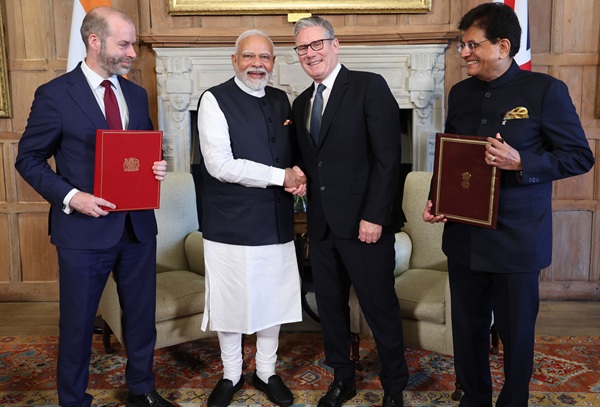.png)
Scotch for Mangoes Works, but Drug IP Concessions Deserved a Red Flag
India’s trade pacts with the UAE, Switzerland, and now the UK are steadily trading market access for deeper concessions on patents, procurement, and regulatory control.


Ajay Srivastava, founder of Global Trade Research Initiative, is an ex-Indian Trade Service officer with expertise in WTO and FTA negotiations.
July 24, 2025 at 4:29 PM IST
India and the UK today signed the Comprehensive Economic and Trade Agreement in London. The agreement is expected to take effect within 6 to 12 months and covers 26 areas, including tariffs, services, digital trade, intellectual property, and procurement.
India and the UK have agreed to sweeping tariff concessions that could reshape their $23 billion goods trade.
With the new deal, goods worth $6.5 billion, or about 45% India’s exports to the UK in 2024-25, will now enter the UK duty-free, down from earlier tariffs of 4% to 16%. These include textiles, footwear, carpets, automobiles, seafood, and fresh fruits such as grapes and mangoes. The remaining $8 billion, covering petroleum, pharmaceuticals, diamonds, and aircraft components, already had zero duty access even without the FTA.
The UK has agreed to eliminate tariffs on all Indian goods, with only a few agricultural items like rice excluded.
On the other side, the UK’s $8.6 billion exports to India face tariffs on over 94% of items. Under the agreement, India will eliminate tariffs on 90% of UK goods. Tariffs on 64% of UK goods will be eliminated immediately, including salmon, lamb, aircraft parts, machinery, and electronics. Another 26%, including chocolates, soft drinks, cosmetics, and auto parts, will see tariffs phased out over the next 10 years.
In a significant concession, India has accepted language in the Intellectual Property chapter of the FTA that subtly curtails its ability to issue compulsory licences, a critical tool for accessing life-saving technologies during emergencies. For the first time in any trade agreement, India has explicitly agreed to wording that stresses the need for “adequate remuneration” to patent holders, aligning with TRIPS Article 31(h). While this may seem like a reaffirmation of existing rights, its inclusion in an FTA elevates this principle to a binding bilateral obligation—potentially constraining India’s flexibility under domestic law.
Even more concerning, the agreement promotes voluntary licensing as the preferred route, alongside so-called “fair, reasonable, and non-discriminatory” (FRAND) practices, which are framed around the interests of patent holders rather than public need. These soft-law concepts carry the risk of being interpreted in ways that delay access to affordable medicines or green technologies, especially during pandemics or climate-related crises.
While India formally retains its sovereign right to issue compulsory licences, the bar has been raised. The FTA’s emphasis on transparency, adequate royalties, and voluntary mechanisms could subject India’s licensing decisions to greater scrutiny, both domestically and internationally. In effect, the FTA shifts India from being a defender of public health exceptions to a rule-taker in IP enforcement—compromising its ability to act swiftly in future emergencies.
Also , by not securing a carve-out or exemption clause on CBAM, India lost a vital opportunity to protect its carbon-intensive exports. From January 2027, the UK can impose carbon taxes on Indian steel and aluminum, even as we grant UK goods duty-free access. That’s a serious asymmetry. Expect the same treatment in India’s FTA with the EU.
The deal pushes past long-standing red lines on tariffs, domestic regulation, and public policy.
India’s recent trade deals with the UAE, Switzerland, and now the UK are following a pattern. Each agreement goes deeper into sensitive areas, opening up new sectors, and giving up control over important policy spaces such as patents, procurement, and regulation. The pressure is growing as India finalises deals with US and EU.
Auto Imports
India has opened a dedicated Tariff Rate Quota for passenger cars from the UK. For large-engine petrol cars above 3000 cc and diesel cars over 2500 cc, traditionally luxury imports, India has committed to lowering the current over 100% customs duty to 10% over 15 years, within a quota starting at 10,000 units and rising to 19,000 in year five. For mid-sized cars—1500–2500 cc diesel / up to 3000 cc petrol—a 50% in-quota duty applies initially, falling to 10% by year five.
Small cars under 1500 cc follow a similar tariff reduction path with a growing quota. These in-quota vehicles enjoy sharply reduced duties, while out-of-quota imports still face tariffs ranging from 95% to 50%, depending on vehicle size and year.
The TRQ marks a major policy shift, especially as India has long used high tariffs to protect its domestic automotive industry. By year five, up to 37,000 UK-built ICE vehicles could enter India annually at just 10% duty, far below the current base rate of 110%. This creates a preferential entry path for high-end British brands such as Jaguar and Land Rover, both owned by Tata Motors, but also for other UK-based exports.
While the measure is capped in volume and spread over 15 years, the policy sets a precedent in opening India’s tightly controlled automobile market to bilateral trade partners—potentially triggering similar demands in future FTAs.
This is India’s first-ever auto tariff concession in any FTA, and it’s likely to trigger similar demands from Japan, the EU, South Korea, and the US.
Alcohol Tariff
India allows duty cuts for UK-origin alcoholic including whisky, brandy, rum, vodka, liqueurs, mead, cider, and tequila. These products, which currently face a base customs duty of 150%, will see steep reductions, but only if they meet a Minimum Import Price threshold of $5 per litre or $6 per 750 ml bottle. For qualifying imports, the duty will be gradually lowered from 110% in Year 1 to 75% by Year 10, through equal annual reductions.
This design helps shield India’s domestic liquor market from low-cost imports while giving premium UK spirits a competitive edge.
More than 30 tariff lines are covered, including popular British exports like Scotch whisky and gin, as well as lesser-known fermented and mixed alcoholic beverages. The deal includes provisions for inflation adjustment of the MIP every 15 years, and requires joint review by both governments before any indexation is applied.
For cosmetics like soaps, perfumes, shaving creams, and nail polish, current tariffs of 10%–20% will either be eliminated on day one or gradually phased out.
India will also remove duties on medical devices from the UK.
India allows tariffs on silver the largest import item from UK to zero in 10 years.
India has excluded several high-sensitivity agricultural products from any tariff concessions. This includes fresh apples, walnuts, whey and modified whey, blue-veined cheese, and specific seed categories like vegetable seeds and sugar beet seeds, gold bars, smartphones etc.
UK exclusion list includes various meat products, egg-based items, semi-milled or fully milled rice, and solid-form cane or beet sugar. The UK has also excluded many prepared or preserved meat products from any tariff concessions.
Government Procurement
India has granted unprecedented market access to UK suppliers in the government procurement chapter, a major shift from its traditionally protectionist approach.
For the first time, India will open approximately 40,000 high-value contracts from central ministries and departments in sectors such as transport, green energy, and infrastructure to UK bidders.
British firms will be allowed to participate through India’s Central Public Procurement Portal and the GeM platform, and will be granted national treatment for all covered procurements.
Importantly, UK-origin goods with just 20% domestic content will be treated as “Class II” local suppliers under India’s Public Procurement Order, a classification previously reserved for Indian suppliers with 20–50% local content. India has, however, retained the right to exclude sensitive areas like health, agriculture, MSME procurement, and low-value contracts.
This is the most extensive GP concession India has offered in any FTA to date and marks a strategic shift away from using public procurement as a tool for domestic industrial development. The 20% local content rule allows UK firms to use up to 80% inputs from third countries, such as China or the EU, while still receiving preferential treatment, effectively diluting the benefits that programs like ‘Make in India’ and Atmanirbhar Bharat were designed to protect.
The access given to the UK could also set a precedent for future FTAs with larger economies like the EU or US, potentially eroding India's ability to use public procurement as a lever for policy goals such as import substitution, domestic capacity-building, and employment generation.
Services Concessions
India has opened key segments of its services economy to British firms, granting access in sectors such as accounting, auditing, financial services, with FDI in insurance capped at 74%, telecom, environmental services, and auxiliary air transport.
UK companies can now offer telecom, construction, and related services in India without needing to establish a local presence, and they are entitled to national treatment, meaning they will be treated on par with Indian firms. India also agreed to recognize UK professional qualifications in select fields like law and accounting, though legal services remain closed.
The agreement ensures no caps on the number of UK service providers, and offers commercial presence rights across multiple domains. However, India retained key regulatory carve-outs, especially in legal services, taxation, and national security, and still lacks full mutual recognition frameworks in most regulated professions.
In contrast, the UK’s services offer to India is more cautious and limited in scope. While it grants commercial presence rights in sectors like computer services, consultancy, and environmental services, its commitments on professional mobility are modest. The UK has offered an annual quota of 1,800 visas for niche roles like yoga instructors and classical musicians, but it has not made binding commitments on broader visa categories, including business visitors or IT professionals. The UK’s refusal to restore post-study work visas is a disappointment for Indian students, and the FTA does not override the UK's points-based immigration system—meaning Indian professionals must still meet regular education, salary, and job offer thresholds.
A key positive is the Double Contribution Convention, which allows over 75,000 Indian workers on short UK assignments to continue paying into India’s social security system without dual contributions. However, this is a temporary fix, and a comprehensive totalization agreement remains pending.
Overall, the UK’s services package shows reluctance to ease mobility for Indian professionals—one of India’s core demands.



